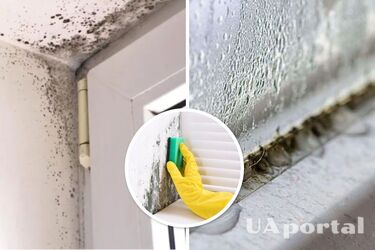Why does mould appear around windows and how to remove it with natural remedies

Condensation often accumulates around windows, which can lead to mould stains. It is important to take the necessary precautions in time, as mould can cause respiratory problems.
Sante Plus has provided some simple and effective tips on how to remove mould around windows. Such stains can damage surfaces, especially wet ones.
Read also: How to remove scratches and stains from parquet with a secret recipe
Why does mould grow around windows?
One of the most common causes of mould is excessive indoor humidity. If the air is too humid, condensation can form on the windows and create an environment conducive to mould growth.
There may also be water leaks near the window, or it may be damaged and leak moisture. Finally, if there is insufficient ventilation in the room, musty air can condense on the windows and promote mould growth.
Four ways to remove mold from windows
Mould can appear on window sills due to condensation and humidity. With the help of four tips, you can fight this phenomenon.
1. Isopropyl alcohol. The antimicrobial and antifungal effects of isopropyl alcohol are very effective against moisture and mould because it effectively kills fungal spores. Therefore, take a spray bottle and mix equal parts isopropyl alcohol and warm water. Then spray on the moldy surface, leave it on for 10 minutes, then wipe it off with a microfiber cloth.
Please test on a small area before use. Some surfaces such as treated wood, painted or varnished surfaces may be damaged.
2. Clove essential oil is an effective mould stain remover. It is ideal against fungi. To do this, mix 10 drops of clove oil, 10 drops of tea tree oil and 100 ml of vinegar. Use a spray bottle to treat the window with this product.
Remember that these oils are not recommended for pregnant and lactating women.
3. White vinegar. If mould stains appear on the frames, joints, or edges of windows, you can remove them using only white vinegar. This aqueous solution kills these fungi and disinfects the surfaces. Simply dampen a sponge or microfiber cloth with white vinegar and then rub vigorously on the problem areas. To remove stubborn marks, mix water and white vinegar in a spray bottle, spray and leave on for 6 hours. Then wipe with a cloth and that's it!
4. Baking soda. Don't forget to ventilate the house well, and use baking soda by placing cups filled with this powder on the windowsill to absorb moisture.
As a reminder, one inexpensive home remedy will help you get rid of unsightly streaks and stains that form on glass.
If you want to get the latest news about the war and events in Ukraine, subscribe to our Telegram channel!
